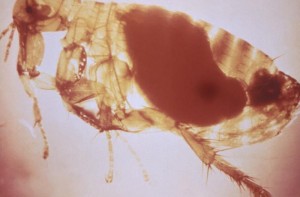The New Mexico Department of Health has confirmed five animal cases of plague in the Santa Fe area since November.

Testing by the department’s Scientific Laboratory Division identified the cases in three cats, one dog and one mouse. All of the animals are from residences in south Santa Fe near the Interstate 25 corridor and between Cerrillos Road and Old Las Vegas Highway.
“Plague activity can occur in New Mexico at any time of year, so it is important to take precautions to avoid rodents and their fleas which can expose you to plague,” Department of Health Secretary Retta Ward said in a press statement. “People can be exposed to plague when pets bring infected fleas back into the home, by caring for a sick pet without proper precautions, or by contact with rodents or fleas outdoors.”
Plague is a bacterial disease of rodents and is generally transmitted to humans through the bites of infected fleas. It can also be transmitted by direct contact with infected animals, including rodents, wildlife and pets, according to the health department.
“We are seeing die offs of rabbits, squirrels, pack rats and various rodents in several areas of New Mexico from both plague and tularemia,” said Dr. Paul Ettestad, public health veterinarian for the Department of Health. “Dogs and cats can be infected with plague through hunting rodents and rabbits or by exposure to their fleas.”
LISTEN: Talking plague and the situation in New Mexico with Dr. Paul Ettestad
Symptoms of plague in humans include sudden onset of fever, chills, headache, and weakness. In most cases there is a painful swelling of the lymph node in the groin, armpit or neck areas. Plague symptoms in cats and dogs are fever, lethargy and loss of appetite. There may be a swelling in the lymph node under the jaw. With prompt diagnosis and appropriate antibiotic treatment, the fatality rate in people and pets can be greatly reduced.
In New Mexico in 2014 there were 17 confirmed cases of plague in dogs and cats. Two humans contracted plague in New Mexico in 2014; one of these is thought to have contracted the disease from his cat. Both patients recovered from the illness. There were 4 human plague cases in 2013 with one fatality.
To prevent plague, the Department of Health recommends:
— Keep your pets from roaming and hunting
— Talk to your veterinarian about using an appropriate flea control product on your pets as not all products are safe for cats, dogs, or your children.
— Clean up areas near the house where rodents could live, such as woodpiles, brush piles, junk and abandoned vehicles.
— Sick pets should be examined promptly by a veterinarian.
— See your doctor about any unexplained illness involving a sudden and severe fever.
— Put hay, wood, and compost piles as far as possible from your home.
— Don’t leave your pet’s food and water where mice can get to it.

